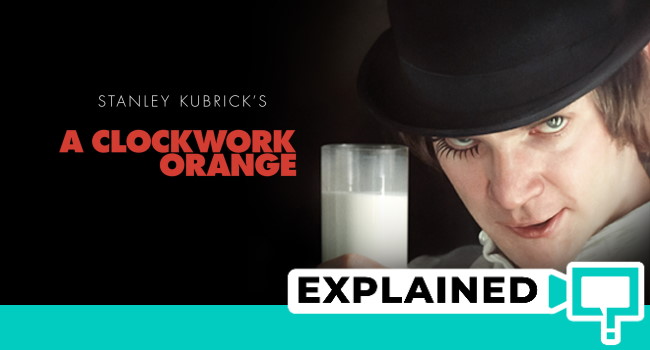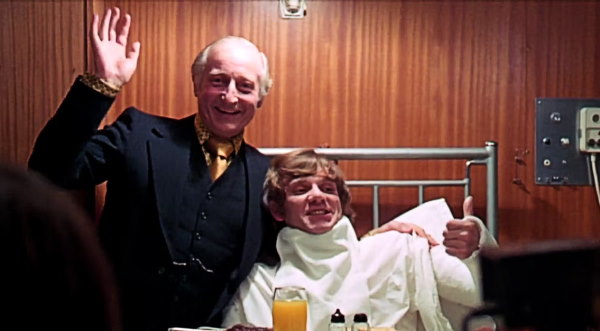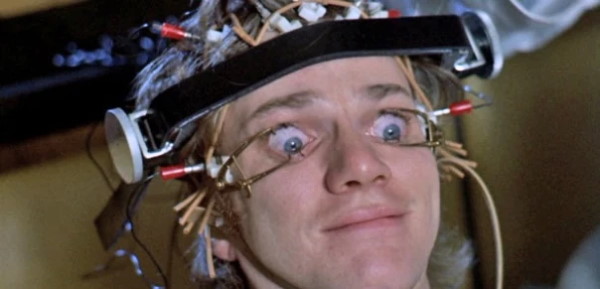Not many movies out there have universal praise and artistic value as Stanly Kubrick’s crime sci-fi A Clockwork Orange. Based on the 1962 novel by the same name, it’s one of the best-known dystopian works, and today, some even consider it speculative fiction. Seeing how the movie’s themes and motifs are just as relevant today as they were in the 60s and 70s, here’s our take on what it was all about; the plot and ending of A Clockwork Orange explained; spoilers ahead.
Hollywordle – Check out my new Hollywood Wordle game!
Where To Watch?
To find where to stream any movie or series based on your country, use This Is Barry’s Where To Watch.
Oh, and if this article doesn’t answer all of your questions, drop me a comment or an FB chat message, and I’ll get you the answer. You can find other film explanations using the search option on top of the site.
Contents
Here are links to the key aspects of the movie:
- – Summary Of The Plot
- – Ending Explained: Was Alex Cured?
- – Movie vs Book: What’s the difference?
- – What happened to Pete?
- – Unique World-Building and Storytelling Choices
- – Main Themes and Motifs
- – What is the movie’s meaning?
A Clockwork Orange: Summary Of The Plot
The story follows Alex DeLarge, a juvenile delinquent in a fictional, dystopian Britain. Alex is a leader of a gang of five delinquents (himself included) with a habit of getting intoxicated on drug-induced milk and performing various violent acts. From the very start, it’s more than clear that, although a monster, Alex DeLarge, just like American Psycho’s Patrick Bateman, is also a product of his culture.
One night, they break into a secluded home, beating a writer, Frank, residing there and violently raping his wife. Several evenings later, during one of their burglaries, Alex is left behind by his comrades and convicted of 14 years in prison.
Two years into his sentence, he’s picked as a test subject for the so-called Ludovico technique. Here, the subjects are conditioned by being injected with drugs which are supposed to make them feel nauseated while watching scenes of horrific violence. The scientists behind the technique hope they can tune people to feel as squeamish when they witness such acts in the future. This reduces jail time and frees up space in prisons. For the purpose of the movie, the experiment works like a charm.
Upon being released from prison, Alex undergoes several ordeals. These range from being tormented by policemen (his two former gang members, Dim and Georgie) to being locked and tortured by the writer (Frank, one of his former victims). He attempts suicide when Frank locks him up and forces him to listen to Beethoven. Alex now detests the song thanks to the Ludovico technique.
A Clockwork Orange: Ending Explained: Was Alex Cured?
The ending of A Clockwork Orange reveals that surviving the suicide attempt causes his condition (created by the Ludovico technique) to be undone. In an effort to hide the illegal procedure and human testing, Alex is given a great job, hush money, and even a public status by the government. Alex stating that he is cured means he has reverted to the evil being he once was.
A Clockwork Orange: Movie vs Book: What’s the difference?
The movie itself was made as an adaptation of a 1962 book written by Anthony Burgess.
The story of how the book came into existence is almost as interesting as the plot of the novel itself. Burgess was mistakenly diagnosed with a cerebral tumor, which made him worry more about his family’s future than his own life.
Had he been an investor, he probably would have studied candlestick patterns in search of a great investment opportunity. Alas, Burgess was a writer, which left him with only one way to make some money before he was gone. Believing that he had only months to live, wanted to write a novel that his widow could monetize. For this reason alone, the entire book was written in under three weeks.
The most significant difference between the book and the movie lies in its final chapters. Namely, in books, the story ends on a lighter note. The reformation achieved through the Ludovico Technique is genuine, and the movie has a bit of a happy ending. Needless to say, the book’s last chapter was omitted in the US because the publisher was convinced that it just wouldn’t be believable enough to the American audience. Unsurprisingly, the filmmaker believed the same.
A Clock Work Orange: What happened to Pete?
Another difference between the book and the movie is the fate of Pete. Unlike Georgie and Dim, Pete doesn’t join the police but gets reformed. He marries a girl named Georgina and finds a great job.
The fact that one gang member changes his life for the better reminds Alex that no one is truly beyond redemption. In the movie, his appearance (after Alex goes to prison) is omitted.
Unique World-Building and Storytelling Choices
An Alien World
One of the first things that come to mind is Kubrick’s incredible world-building methods. From the very first scene, we notice that the world feels incredibly alien. The clothes of the characters are different. Their language, at least the slang, vastly differs from standard English. Even the setting of a bar in which delinquent youth drinks not alcohol but milk laden with drugs seems both dystopic and highly disturbing.
Language
The language creates a disconnect between our world and that portrayed in the movie. Unlike Tolkien, Burgess didn’t have to invent an entirely new language. Instead, he used Slavic words as slang. Seeing as how only the youthful delinquents used this slang, it’s a clear allusion to the existence of a separate subculture and a generation gap in this fictional society.
Music
The use of music is unique and creates a deliberate contrast within this fictional world. Classical music, often associated with high society, is used during some of the most disturbing, violent, and ethically dubious scenes. This is an important reminder that some of the greatest monsters in history (Nazi party officials, the high command of Imperial Japan, etc.) did not belong to the marginal layer of society but were, in fact, its elite.
The use of Beethoven’s Ninth during the Ludovico effect is a perfect example of this. Everything is composed, civilized, and clinical. What many people tend to forget is that these are similar conditions to those in which some of history’s most inhumane experiments were conducted.
Main Themes and Motifs
Psychiatry and Will
One of the first themes in the movie is that of psychiatry and our attempt to use this medical science for social engineering purposes. In A Clockwork Orange, the experiment backfires by proving itself to be easily reversible.
This also plays heavily into our definition of goodness. According to both religious and philosophical beliefs, true goodness must come out of one’s free will. Resisting the temptation for violence is only reliable when done out of one’s conviction, not psychological conditioning.
Violence
Another concept worth discussing is a social commentary on the movie as a whole. Parallels between the cruelty of street gangs and lab staff are simply uncanny. Moreover, two of Alex’s gang members are later recruited by the police. This reinforces two critical theories. You see, an industry that is violent by nature needs people with a natural inclination for violence. The biggest difference here is whether they’re going to be government employees (police) or work in the private sector (as gang members).
The Ignored Youth
Juvenile delinquency, for the most part, is ignored by both parents and the government, at least until it becomes too big of a thorn in the side. Alex’s mother spends her days watching TV instead of paying active attention to what her child is doing.
His probation officer is too busy threatening (and even molesting him) to actually try and do anything about his reformation. In fact, the only group actively interested in his reformation are the scientists behind the Ludovico effect, and even they do this for their own twisted purposes. A society that pays no heed to its youth is a society with no future.
A Clock Work Orange: What is the movie’s meaning?
So, what does it all mean? Alex, as first portrayed, is evil incarnate, which is why his grand return is really not surprising. Evil always finds a way. Any methods to eradicate it via a scientific experiment are doomed to fail. The only way for a society to stand against this phenomenon is to pay close attention to what its youth is doing.
What were your thoughts on the plot and ending of A Clockwork Orange? Too crazy? Too brilliant? Do leave your comments below.

Stacey is a talented freelance writer passionate about all things pop culture. She has a keen eye for detail and a natural talent for storytelling. She’s a super-fan of Game of Thrones, Cats, and Indie Rock Music and can often be found engrossed in complex films and books. Connect with her on her social media handles to learn more about her work and interests.



